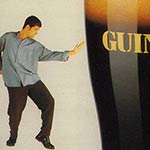Black future? |
 |
| Colm Carey retraces the steps that define the plain truths behind Guniess today |
One of the biggest tourist attractions in Dublin is the Guinness Tower. Visitors get to see the home of the Anna Livian brew from the heady heights of Guinnessland in the heart of the Liberties. It doesn’t get much more authentic than that.
In many people’s minds, Guinness is as Dublin as the late great Luke Kelly and Brendan Behan. Over many years, the Guinness brewery provided employment for generations of real Dubs and blow-ins alike. It occupies a central place in the city’s physical, cultural and psychological landscape.
Years ago, there was a walking tour of the brewery. The tour was a favoured outing for college students who looked forward to the free pints pulled by expert barmen in the visitors’ bar. The “troubles” up North put an end to the walkabout as the security experts initiated a disconnection between people and brand.
When you gave blood in the 1970s, you would get a bottle of Guinness as a reward. The black stuff helped rebuild the red stuff and so launched many a Guinness drinker’s career. If you chatted nicely to the nurse you might get a second helping. Women in the Rotunda got a bottle of Guinness as a reward for giving birth on the basis that it replaced iron in the blood. Old folk were prescribed the stout as a tonic on cold winter nights. If one was good for you, surely two could only improve matters.
Postcards proudly declared that Guinness was good for you and that it gave you strength. No one doubted or challenged the truth of such statements. You could drink your Guinness in peace, confident in the knowledge that while other drinks might be of dubious character, the pint of plain was your only man.
Drinking Guinness was the mark of real men. If you were a shade under age, asking for a lager might get you chucked out of the pub. But boldly ordering a pint of stout usually got you the benefit of the doubt from even the most pernickety barmen.
Guinness had the kind of connection not just with consumers but with a nation of which most brands can but dream . But while there are still people who look on Guinness with near religious fervour, it has lost much of its substance and soul.
Marketing looks to create a sense of fellowship among consumers. Vast amounts of time and money are spent trying to build relationships between brands and consumers. The attempts are often one-dimensional and last only as long as a brand team’s tenure.
At its height, there was no division between Guinness the drink and Guinness the institution. People who worked in St James’s Gate were admired and respected. The way the delivery guys could bounce a keg onto a cushioned sack before rolling it down a hole in the footpath was part of the folklore of the brand.
At some point the connection between Guinness and the citizens of Dublin broke down. Uncle Arthur began to regard the citizens as consumers, focusing only on those who conformed to a demographically-defined target audience.
The brewery shifted from being spiritually owned by the people of Dublin to the status of a corporate entity. The people who ran it were no longer seen as net contributors to the life of the city but as profit takers managed from abroad.
This did not happen overnight. Like all dramatic shifts, change came dropping slow. But happen it did. As the company, which became Diageo, disengaged from the people, the people disengaged from the brand. In a game where style, speed, ease and convenience are key values, a brand like Guinness struggles to compete.
 |
MIDAS TOUCHJoe McKinney was the last meaningful contact point with young Irish beer drinkers, before Diageo moved its advertising to Britain. But HHCL’s ‘Big’ concept proved to be a major let-down and Guinness advertising returned to Dublin and IIBBDO. |
As Guinness advertising became more stylised, the brand became less imposing. Current moves to focus back on product quality and unique product values are a step in the right direction but there are new obstacles in the way of progress.
When the Guinness ad account left Dublin for London – via a brief stint at Ogilvy & Mather – local agencies decried the appointment of HHCL. Many people felt Arks had eventually got it right again with actor Joe McKinney dancing around a pint.
Guinness had left Ireland and HHCL’s ‘Big’ campaign was born. Tim Kelly, marketing boss at the time, was soon obliged to defend the new ads. In remarks which could vie with former US defence secretary Donald Rumsfeld for hubris over his excuse for invading Iraq, Kelly insisted the ads would help lure recruits.
This year’s Sharks awards in Kinsale saw a return to the halcyon days of award-winning Guinness advertising. Irish International BBDO and its ‘Music Machine’ TV commercial may help arrest the steady decline in the brand’s popularity among younger drinkers, but it’s hardly likely to prove as dramatic as the ad’s special fx.
Guinness finds it almost impossible to be accepted as a take-home beer. Draught in a bottle, widgets in cans and attempts to convince us that the home-poured pint of porter is equal to the pub version have fallen on deaf ears. The ubiquitous lager fits the bill when all you want is a glass of cold, fizzy alcohol.
No matter what they say, a home-poured Guinness is a disappointment. People prefer to avoid buying it rather than have this sad shadow of a Guinness remind them that they should be in the bosom of a proper pub surrounded by the clink of glasses, the buzz of conversation and the hum of their fellow drinkers.
Ireland’s wet and grey summer is thought to have lifted Guinness sales, as the market for barbecues and dining al fresco dried up. Only two years ago, Diageo transferred the brewing of Guinness for the entire British market to St James’s Gate, resulting in a 50 per cent increase in production in Dublin. But now that too could all change.
David Varian, operations director at St James’s Gate at the time, told The Irish Times that the move of brewing to Dublin was intended to support the future growth and development of the Guinness brand. “We needed to get our business into the right shape… focusing on St James’s Gate is helping us do that.”
Two years can be a long time in the pints business. Diageo recently launched a strategic review of its brewing operations in Ireland but has refused to comment on speculation that it may sell some or all of its valuable Liberties property.
 |
WIDESPREAD REIGNSince 1759, Guinness and its family of friends has used its links with Ireland to good effect. But sentiment counts for little in the drinks business and while sales in Ireland continue to drop, its international markets, including Africa, are on the rise. |
Diageo managing director Michael Ioakimides told the media that the company was a €40 billion capital business and they were not interested in property deals. Iaokimides referred to the magic and history of the St James’s Gate brewery.
As Longfellow said “all things must change to something new, to something strange”. For a brand like Guinness, adapting to this strange new world is an ongoing challenge. As traditional pub culture declines, the brand struggles to find a home.
Time will tell the extent to which it succeeds.
Colm Carey (colm@theresearchcentre.com) is a psychologist and qualitative researcher.









